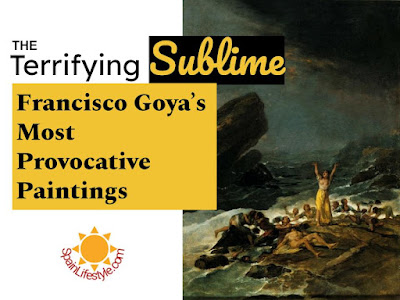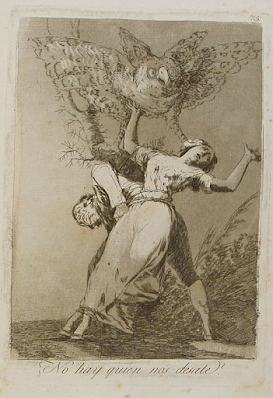THE UNSOLVED MYSTERY OF GOYA'S MISSING SKULL
THE TERRIFYING SUBLIME * GOYAS MOST PROVOCATIVE PAINTINGS * TBA
In this lecture we explore a genre of visual art that Goya spearheaded. While others were painting beautiful pictures, Goya was breaking the boundaries of established art aesthetics. The paintings in this lecture were not commissioned works, but self-created, so Goya had the freedom to realise his ideas
* Report by Karla Ingleton Darocas. Hons. B. A. (KarlaDarocas.com)
JAVIER GOYA AND HIS DOG
DOGS OF LEISURE
After the war between Spain and the First French Empire, which began in 1808 with the invasion of Napoleonic troops and ended in 1814 with the return of Fernando VII to Spain and absolute power, Spain was destined to shake up its social structures with the emergence of diversified social classifications.
There were still the noble families with land titles and wealth, and of course the peasants who owned nothing, but now there was a newly emerged stratum in Spanish society based on the wealth created by trade, manufactures, modern agriculture, retail, professions such as doctors and lawyers, and even arts and crafts. These self-employed people and family businesses formed a social class based on materialism and the pursuit of respectability called the bourgeoisie.
The bourgeoisie was now the class of people who wanted companion dogs to demonstrate their ability to spend their leisure time, and so the miniature dog breeds made a big comeback. Small dogs were now a symbol of success, a happy family life and a home because they had a good income.
GOYA KNEW THE SECRET TO THE WITCHES FLIGHT
Since Halloween and the Day of the Dead are very close to each other, who better to take up the theme of witches' flight than Francisco Goya. Traditionally, witches were believed to use a broom to move through the air and assist the coven in places far from their usual haunts.
The women accused of witchcraft were women who took care of the home: wives, midwives, servants, etc. And what do these people have in common? A broom! It stands to reason that the broom was a representation of women and thus became the witches' tool.
Goya, who knew the aspects of witchcraft well, captured the moment when an old witch initiates a young woman into these practises. But he also knew that it was not the broom that gave the witches their flying abilities.
* Report by Karla Ingleton Darocas. Hons. B. A. (KarlaDarocas.com)
GOYA ATTACKED ARRANGED MARRIAGES WITH HUMOUR
Francisco José de Goya y Lucientes (1746 - 1828) paintings, drawings and engravings reflected contemporary historical upheavals. He supported the new enlightened and educated spirit of the times by opposing arranged marriages. At that time, the function of marriage was merely a means to promote the economic or social success of the family and ignored the pain that people suffered.
** Report by Karla Ingleton Darocas. Hons. B. A. (KarlaDarocas.com)
-
THE ENIGMA Dionisio Fierros (1827-1894) was a Spanish Romantic painter who painted a “Vanitas”, an allegorical still life, for the Marquis ...
-
The most frequently reproduced motif throughout the history of art, especially in Western art, is the subject of the mother with child. Th...
-
"Galatea of the Spheres"," painted by the surrealist artist Salvador Dalí in 1952, is a remarkable testimony to Dalí's u...







